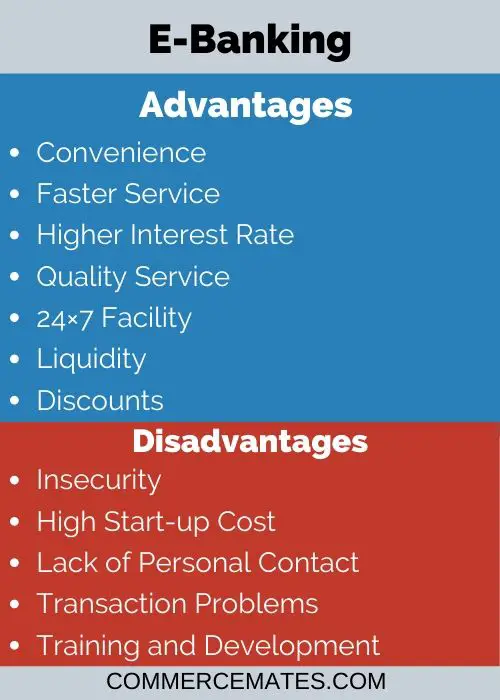Contents
Meaning of E-Banking
E-banking is a system that provides various online banking services to customers using the internet and telecommunication network. This is a means through which customers are able to access their bank account online and perform various financial transactions via the internet. It is also known as internet banking, virtual banking or online banking.
E-banking is safe, convenient and fast electronic service that allows its customers to carry out banking transactions at any place without visiting their bank branch. E-banking service is available all the time to customers that is 24 hours a day and 7 days a week.
Here funds are transferred through the transmission of electronic signals instead of an exchange of various paper documents like cash, cheque etc. There are different types of E-banking services available such as ATM, Mobile Banking, Debit cards, Telebanking, EFT (Electronic Fund Transfer) System and ECS (Electronic Clearing Services).

Advantages of E-banking
- Convenience: E-banking provides great convenience to customers for performing various financial transactions. People can easily access their bank accounts anytime just sitting at their homes without visiting their bank.
- Faster Service: It provides speedy service as peoples do no need to stand in queues for paying their bills or transferring funds. Funds get transferred instantly from one account to another in less time using online payment systems.
- Higher Interest Rate: Online banking services provide higher interest rates to customers. It has reduced the operational cost of banks which helps them in providing better interest rates on deposits of customers.
- Quality Service: Internet banking has improved the service quality to customers. It is efficient, safe and easy to do payments using online banking. Customers are able to monitor all transactions related to their accounts using e-banking apps.
- 24×7 Facility: E-banking services are available to customers at all times that are 24 hours a day and on all 7 days during a week. Customers can have access to banking products and services from anywhere at any point of time.
- Liquidity: It provides better liquidity of funds to customers. They can easily withdraw money from ATM machines at any time and from anywhere.
- Discounts: Another important advantage of using online banking services is that it helps customers in availing various discounts. Peoples enjoy various discount schemes on retail outlets on usage on credit or debit cards.
Disadvantages of E-banking
- Insecurity: E-banking services face various insecurity issues resulting from hacking done by online hackers. Customers may lose their credentials while doing payments and may cause huge financial loss.
- High Start-up Cost: It requires huge expenditure for installing various hardware components, software, computers, modem, and internet network. Banking organizations need large expenditures for starting internet banking services.
- Lack of Personal Contact between Customer and Banker: Online banking faces a barrier of direct interaction between clients and banks. Customers interacts with bank using their websites online. Sometimes customers are not able to resolve their issues by connecting with the bank virtually.
- Transaction Problems: Many times banking servers are down thereby leading to transaction failure. Customers face difficulty in doing payments online which causes inconvenience.
- Training and Development: Banks need to provide training to their staff for providing better online service to their customers. It requires huge amount of investment for maintaining qualified and trained staff.